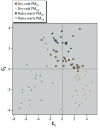TNFα and IL-6 Responses to Particulate Matter in Vitro: Variation According to PM Size, Season, and Polycyclic Aromatic Hydrocarbon and Soil Content
- PMID: 26372663
- PMCID: PMC4829995
- DOI: 10.1289/ehp.1409287
TNFα and IL-6 Responses to Particulate Matter in Vitro: Variation According to PM Size, Season, and Polycyclic Aromatic Hydrocarbon and Soil Content
Abstract
Background: Observed seasonal differences in particulate matter (PM) associations with human health may be due to their composition and to toxicity-related seasonal interactions.
Objectives: We assessed seasonality in PM composition and in vitro PM pro-inflammatory potential using multiple PM samples.
Methods: We collected 90 weekly PM10 and PM2.5 samples during the rainy-warm and dry-cold seasons in five urban areas with different pollution sources. The elements, polycyclic aromatic hydrocarbons (PAHs), and endotoxins identified in the samples were subjected to principal component analysis (PCA). We tested the potential of the PM to induce tumor necrosis factor alpha (TNFα) and interleukin 6 (IL-6) secretion in cultured human monocytes (THP-1), and we modeled pro-inflammatory responses using the component scores.
Results: PM composition varied by size and by season. PCA identified two main components that varied by season. Combustion-related constituents (e.g., vanadium, benzo[a]pyrene, benzo[a]anthracene) mainly comprised component 1 (C1). Soil-related constituents (e.g., endotoxins, silicon, aluminum) mainly comprised component 2 (C2). PM from the rainy-warm season was high in C2. PM (particularly PM2.5) from the dry-cold season was rich in C1. Elevated levels of cytokine production were associated with PM10 and C2 (rainy-warm season), whereas reduced levels of cytokine production were associated with PM2.5 and C1 (dry-cold season). TNFα secretion was increased following exposure to PM with high (vs. low) C2 content, but TNFα secretion in response to PM was decreased following exposure to samples containing ≥ 0.1% of C1-related PAHs, regardless of C2 content. The results of the IL-6 assays suggested more complex interactions between PM components and particle size.
Conclusions: Variations in PM soil and PAH content underlie seasonal and PM size-related patterns in TNFα secretion. These results suggest that the mixture of components in PM explains some seasonal differences in associations between health outcomes and PM in epidemiologic studies.
Citation: Manzano-León N, Serrano-Lomelin J, Sánchez BN, Quintana-Belmares R, Vega E, Vázquez-López I, Rojas-Bracho L, López-Villegas MT, Vadillo-Ortega F, De Vizcaya-Ruiz A, Rosas Perez I, O'Neill MS, Osornio-Vargas AR. 2016. TNFα and IL-6 responses to particulate matter in vitro: variation according to PM size, season, and polycyclic aromatic hydrocarbon and soil content. Environ Health Perspect 124:406-412; http://dx.doi.org/10.1289/ehp.1409287.
Conflict of interest statement
The authors declare they have no actual or potential competing financial interests.
Figures



References
-
- Afifi AA, Clark VA, May S. 2004. Computer-Aided Multivariate Analysis. 4th ed. Boca Raton, FL:Chapman and Hall/CRC.
-
- Alfaro-Moreno E, Torres V, Miranda J, Martínez L, García-Cuellar C, Nawrot TS, et al. Induction of IL-6 and inhibition of IL-8 secretion in the human airway cell line Calu-3 by urban particulate matter collected with a modified method of PM sampling. Environ Res. 2009;109:528–535. - PubMed
Publication types
MeSH terms
Substances
Grants and funding
LinkOut - more resources
Full Text Sources
Other Literature Sources
Research Materials
Miscellaneous

